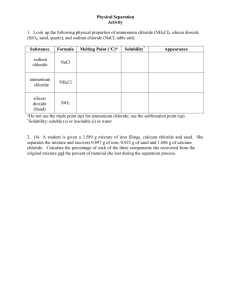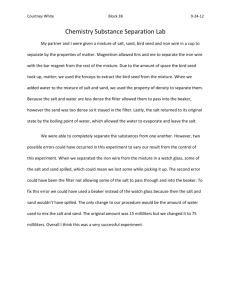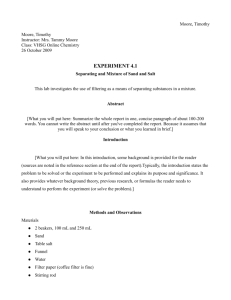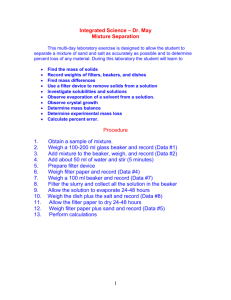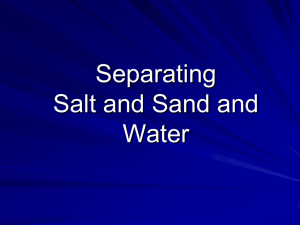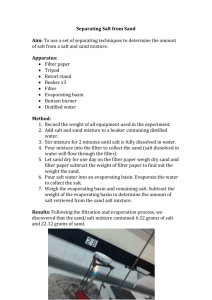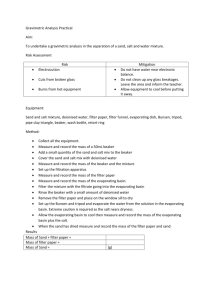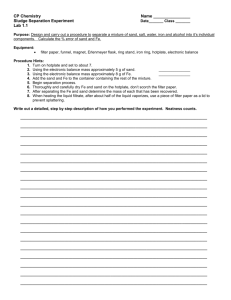Day 11 Separation Lab - WaylandHighSchoolChemistry
advertisement
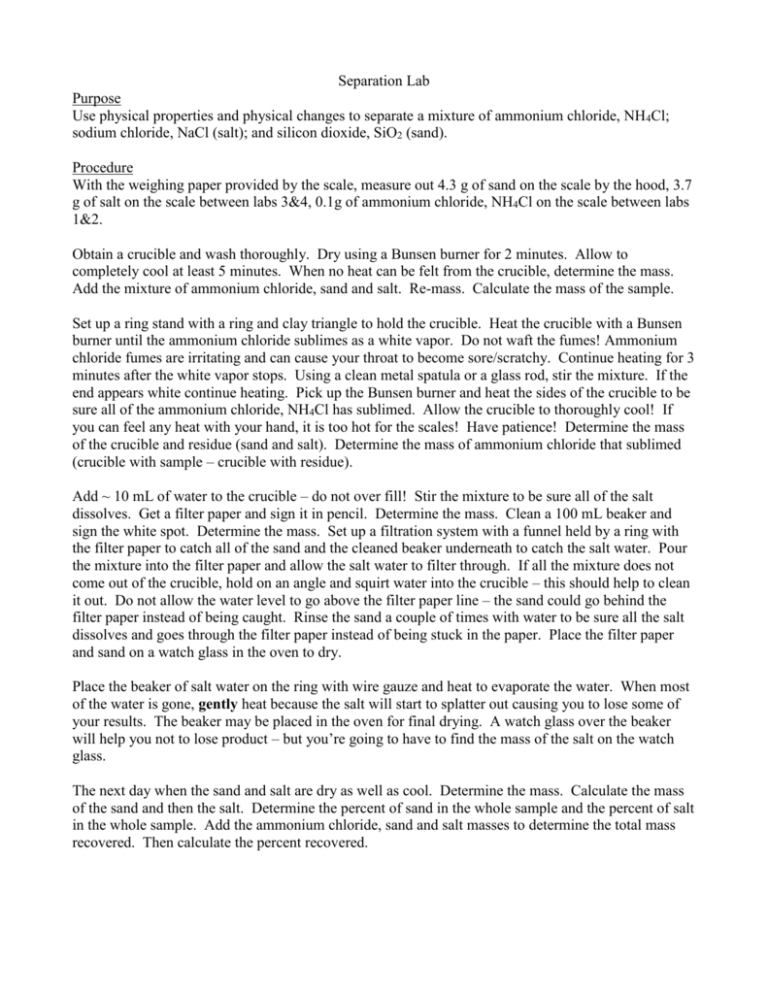
Separation Lab Purpose Use physical properties and physical changes to separate a mixture of ammonium chloride, NH4Cl; sodium chloride, NaCl (salt); and silicon dioxide, SiO2 (sand). Procedure With the weighing paper provided by the scale, measure out 4.3 g of sand on the scale by the hood, 3.7 g of salt on the scale between labs 3&4, 0.1g of ammonium chloride, NH4Cl on the scale between labs 1&2. Obtain a crucible and wash thoroughly. Dry using a Bunsen burner for 2 minutes. Allow to completely cool at least 5 minutes. When no heat can be felt from the crucible, determine the mass. Add the mixture of ammonium chloride, sand and salt. Re-mass. Calculate the mass of the sample. Set up a ring stand with a ring and clay triangle to hold the crucible. Heat the crucible with a Bunsen burner until the ammonium chloride sublimes as a white vapor. Do not waft the fumes! Ammonium chloride fumes are irritating and can cause your throat to become sore/scratchy. Continue heating for 3 minutes after the white vapor stops. Using a clean metal spatula or a glass rod, stir the mixture. If the end appears white continue heating. Pick up the Bunsen burner and heat the sides of the crucible to be sure all of the ammonium chloride, NH4Cl has sublimed. Allow the crucible to thoroughly cool! If you can feel any heat with your hand, it is too hot for the scales! Have patience! Determine the mass of the crucible and residue (sand and salt). Determine the mass of ammonium chloride that sublimed (crucible with sample – crucible with residue). Add ~ 10 mL of water to the crucible – do not over fill! Stir the mixture to be sure all of the salt dissolves. Get a filter paper and sign it in pencil. Determine the mass. Clean a 100 mL beaker and sign the white spot. Determine the mass. Set up a filtration system with a funnel held by a ring with the filter paper to catch all of the sand and the cleaned beaker underneath to catch the salt water. Pour the mixture into the filter paper and allow the salt water to filter through. If all the mixture does not come out of the crucible, hold on an angle and squirt water into the crucible – this should help to clean it out. Do not allow the water level to go above the filter paper line – the sand could go behind the filter paper instead of being caught. Rinse the sand a couple of times with water to be sure all the salt dissolves and goes through the filter paper instead of being stuck in the paper. Place the filter paper and sand on a watch glass in the oven to dry. Place the beaker of salt water on the ring with wire gauze and heat to evaporate the water. When most of the water is gone, gently heat because the salt will start to splatter out causing you to lose some of your results. The beaker may be placed in the oven for final drying. A watch glass over the beaker will help you not to lose product – but you’re going to have to find the mass of the salt on the watch glass. The next day when the sand and salt are dry as well as cool. Determine the mass. Calculate the mass of the sand and then the salt. Determine the percent of sand in the whole sample and the percent of salt in the whole sample. Add the ammonium chloride, sand and salt masses to determine the total mass recovered. Then calculate the percent recovered. Chemistry Lab Separation Lab Data Record Names__________________________________________ Hour_______ Directions: Fill in the following blanks with your observations and results. Remember your units and keep 3 digits in all numbers. Mass of sand (4.3g) _____ Mass of salt (3.7g) _____ Mass of ammonium chloride (0.1g) _____ Mass of evaporating dish and unknown _______ Mass of evaporating dish _______ Mass of unknown _______ Mass of evaporating dish and residue after sublimation _______ Mass of NH4Cl (ammonium chloride) _______ Percent of NH4Cl _______ Mass of watch glass, filter paper and SiO2 _______ Mass of watch glass and filter paper _______ Mass of SiO2 (silicon dioxide) _______ Percent of SiO2 _______ Mass of beaker and NaCl _______ Mass of beaker _______ Mass of NaCl _______ Percent of NaCl (sodium chloride) _______ Mass of separated components _______ Percent recovery of all components _______ % error __________ % error __________ % error __________
